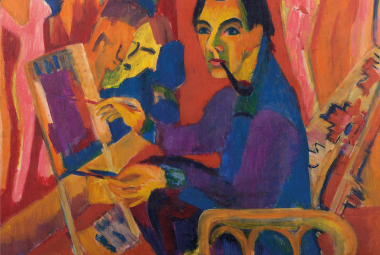Hendrik de Vries
Groningen 1896 – Haren (Gr.) 1989
Hendrik de Vries is considered to be a poet who also drew and painted. If he had got his way in his youth it would have been the other way around. He wanted to be a painter who also wrote poems. He was the middle of the three sons of Wobbe de Vries, linguist and teacher of Dutch at the Stedelijk Gymnasium (later Praedinius Gymnasium) in Groningen, and Frouwktje Opten. The family came from the Groningen countryside.
Drawing and writing poetry
After elementary school, Hendrik proved unable to follow the ‘Hogere Burgerschool’ education, because he had no talent for learning subjects and mathematics. He taught himself languages and further developed his skills in drawing and poetry, which he had been practicing both since childhood. Although his father gave him permission to dedicate himself to being an artist in 1916, his mother opposed this choice of profession. Because she suffered from a severe form of manic depression for which she was repeatedly cared for, he agreed to her wish and accepted a subordinate position in the Groningen municipal archive.
Friendships with Wobbe Alkema, Johann Faber and Jan van der Zee stimulated his artistic development. His first collection of poems appeared in 1920 under the title De nacht. In the 1920s and 1930s he became one of the leading Dutch poets. But he refused to become a member of De Ploeg as a literary man because he wanted to be recognized as a visual artist.
The early work of the painter Hendrik de Vries has an expressionist side. His images of farms and landscapes are in a darker colour than those of most painters of De Ploeg. In addition, he drew fantastic representations of future cities. His acquaintance with the work of Alfred Kubin and especially that of Francisco de Goya stimulated him to continue with the ‘fantasmagorical’ images and demonic dream fantasies that dominated his drawings in his early years. In the volume Diseño jondo (1966), pen and brush drawings of heads of people are collected that show a mixture of beauty and demonic features. He incorporated the same themes also in his poetry, in particular in the collection Tovertuin (1946).


Spain
Little has been more important to his artistic and literary work than his acquaintance with Spain, which fascinated him from his childhood on. He taught himself Spanish and made twelve trips through the country from 1924 to 1936. Sketches and photos he made on these trips became the source for depictions of Spanish children, dancers, landscapes and bullfight scenes. For De Vries bullfights and Spanish dance symbolized the interaction between intense passion and strict control. He did not visit Spain anymore after 1936, but in his post-war work the memories of the country and the Spanish people continued to dominate his drawings and paintings. Although he sometimes painted rather successful portraits, Hendrik de Vries was first and foremost an artist of the inner imagination in which imagination mixed with remembered realism. He never worked directly after nature.
Hendrik de Vries married in 1946 – his parents had already died by then – to the four-year younger Riek van der Zee, with whom he went to live in Haren in the house 't Woeste Hoekje on the Onnerweg. He resigned from the municipal archive in 1947 to live by his pen. He became very active as an art and poetry critic in local and national papers magazines. In addition, he tried to sell his visual work.
Hendrik de Vries was a loner who had little interest in the social life of De Ploeg. He did, however, regularly participate in exhibitions. In 1972 he canceled his membership because he felt alienated from De Ploeg.
Literature
Text: Jan van der Vegt.
Hendrik de Vries, Verzamelde gedichten, Amsterdam 1992. Hendrik de Vries, ’t Geheimste is geheim gebleven, De Ploeg-reeks nr. 3, catalogus Groninger Museum 1996. Jan van der Vegt, Hendrik de Vries. Biografie, Amsterdam 2006 Jan van der Vegt, ‘Verbeelde gevechten. Hendrik de Vries als schilder van het stierengevecht’, Ploeg Jaarboek 2007, Groningen 2008.
